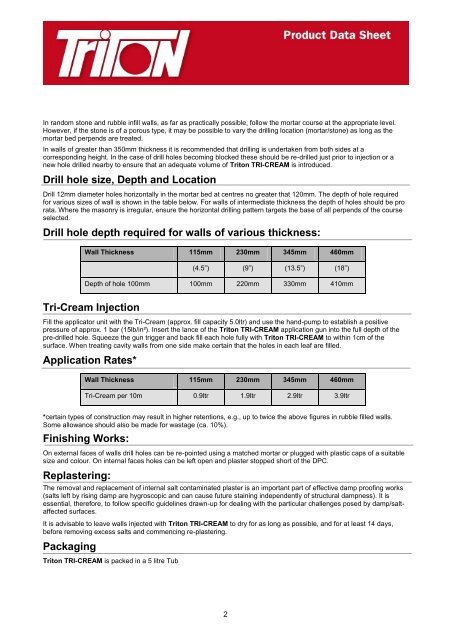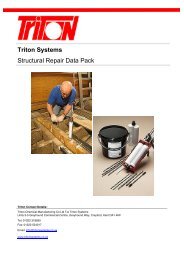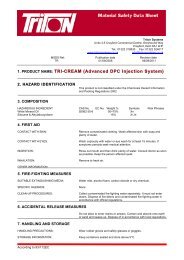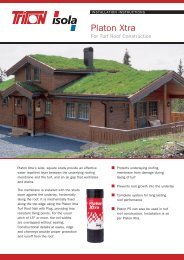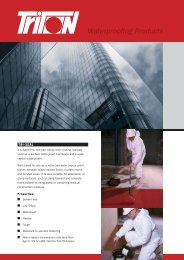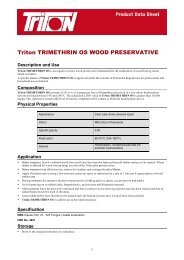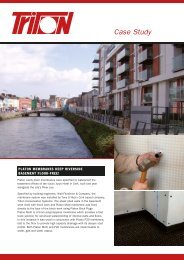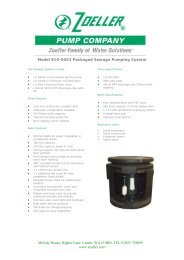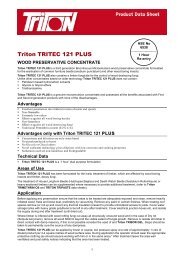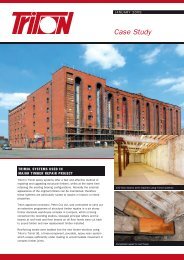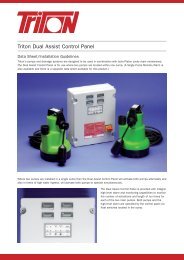Tri-Cream Data Sheet Download - Triton Chemicals
Tri-Cream Data Sheet Download - Triton Chemicals
Tri-Cream Data Sheet Download - Triton Chemicals
Create successful ePaper yourself
Turn your PDF publications into a flip-book with our unique Google optimized e-Paper software.
In random stone and rubble infill walls, as far as practically possible, follow the mortar course at the appropriate level.<br />
However, if the stone is of a porous type, it may be possible to vary the drilling location (mortar/stone) as long as the<br />
mortar bed perpends are treated.<br />
In walls of greater than 350mm thickness it is recommended that drilling is undertaken from both sides at a<br />
corresponding height. In the case of drill holes becoming blocked these should be re-drilled just prior to injection or a<br />
new hole drilled nearby to ensure that an adequate volume of <strong>Tri</strong>ton TRI-CREAM is introduced.<br />
Drill hole size, Depth and Location<br />
Drill 12mm diameter holes horizontally in the mortar bed at centres no greater that 120mm. The depth of hole required<br />
for various sizes of wall is shown in the table below. For walls of intermediate thickness the depth of holes should be pro<br />
rata. Where the masonry is irregular, ensure the horizontal drilling pattern targets the base of all perpends of the course<br />
selected.<br />
Drill hole depth required for walls of various thickness:<br />
Wall Thickness 115mm 230mm 345mm 460mm<br />
(4.5”) (9”) (13.5”) (18”)<br />
Depth of hole 100mm 100mm 220mm 330mm 410mm<br />
<strong>Tri</strong>-<strong>Cream</strong> Injection<br />
Fill the applicator unit with the <strong>Tri</strong>-<strong>Cream</strong> (approx. fill capacity 5.0ltr) and use the hand-pump to establish a positive<br />
pressure of approx. 1 bar (15lb/in²). Insert the lance of the <strong>Tri</strong>ton TRI-CREAM application gun into the full depth of the<br />
pre-drilled hole. Squeeze the gun trigger and back fill each hole fully with <strong>Tri</strong>ton TRI-CREAM to within 1cm of the<br />
surface. When treating cavity walls from one side make certain that the holes in each leaf are filled.<br />
Application Rates*<br />
Wall Thickness 115mm 230mm 345mm 460mm<br />
<strong>Tri</strong>-<strong>Cream</strong> per 10m 0.9ltr 1.9ltr 2.9ltr 3.9ltr<br />
*certain types of construction may result in higher retentions, e.g., up to twice the above figures in rubble filled walls.<br />
Some allowance should also be made for wastage (ca. 10%).<br />
Finishing Works:<br />
On external faces of walls drill holes can be re-pointed using a matched mortar or plugged with plastic caps of a suitable<br />
size and colour. On internal faces holes can be left open and plaster stopped short of the DPC.<br />
Replastering:<br />
The removal and replacement of internal salt contaminated plaster is an important part of effective damp proofing works<br />
(salts left by rising damp are hygroscopic and can cause future staining independently of structural dampness). It is<br />
essential, therefore, to follow specific guidelines drawn-up for dealing with the particular challenges posed by damp/saltaffected<br />
surfaces.<br />
It is advisable to leave walls injected with <strong>Tri</strong>ton TRI-CREAM to dry for as long as possible, and for at least 14 days,<br />
before removing excess salts and commencing re-plastering.<br />
Packaging<br />
<strong>Tri</strong>ton TRI-CREAM is packed in a 5 litre Tub<br />
2


